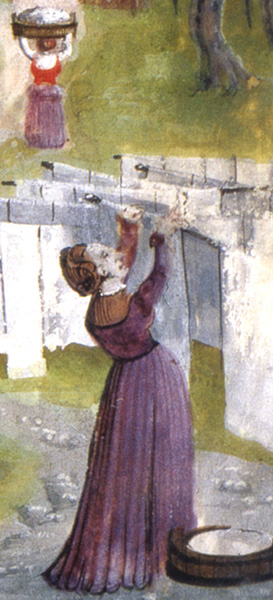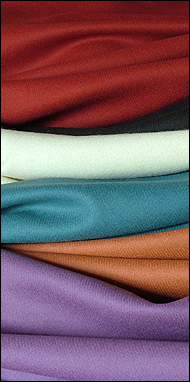



Example of Royal Purple
and Common Violet
Photos of Reproduction Wools
Fabric Color Myths
Myth: All purple colors in all fabrics are reserved for Royalty only.
'None shall wear in his apparel cloth of gold or silver tissued, silk of color purple under the degree of an earl, except Knights of the Garter in their purple mantles only' (emphasis mine).
~ From Elizabeth I's Decrees (1597 statue of apparel)
This is a theatrical decree in modern renaissance faires that seems to have gone too far. Some groups don't even allow purple gemstones or anything else purple for their actors.
In the Roman to medieval periods, Imperial purple was derived from a process that required thousands of mullosks, murex trunculus, as seen in this video, The Worst Jobs in History, The Royal Age pt 6 (the purple makers). This process was lost to history until recently, as the purple dyers were killed off during the Seige of Constantinople in 1204.
The silk of color purple during this English renaissance was derived by a process using "grain", an expensive imported dye made from insects, which could be kermes or cochineal, either dyed over an indigo silk or from what was placed into the dye bath. There are other shades of purple available to the common folk, the most common is from madder and woad (a common form of indigotin in England) onto wool. The highland Scots even have a lichen, orchil, that produces a purple dye. These can and were used on other fibers like wool which are not limited by sumptuary laws.
The first image above left show what silk of the color purple on the cloaks of Henry's Garter Knights looks like.
The second image shows what would be worn by someone of middle class rank, which shows a violet shade. There are two German women wearing this color above, both doing a menial task of laundry, so they are obviously not nobility, although the foreground lady may be the ranking lady of her estate. You can see a larger detail from the illumination here, which shows more women in other colors worn by the common folk.
The lower two images show modern fabrics available from the Tudor Tailor group for the modern re-enactor. The wools include madder red, violet, tawney (a yellow orange), woad blue, and "sheep's color" (undyed) wool.
Henry VIII and the Knights of the Garter, c.1534, in an illumination from the register of the Garter known as the Black Book.
Splendor Solis c. 1531-2, School of Nuernberg (inventory no. 78D3, folio 31 recto.)
Two images of reproduction dyed wools from The Tudor Tailor web site. All are fabrics in colors that were availble to the common folk. Fabrics available for purchase here.
Thanks to Lisa Sinervo for sharing her copy of Elizabeth's decrees with me.